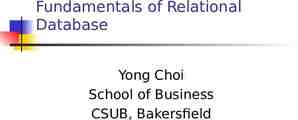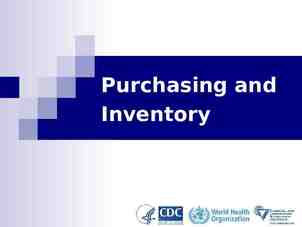ACCELERATED NURSING PROGRAMS Ferris State University
14 Slides9.63 MB
ACCELERATED NURSING PROGRAMS Ferris State University Stephanie Mansfield
Question at Issue Are accelerated nursing programs effective?
Purpose With the impending nursing shortage we are seeing more and more non traditional students choosing nursing as their field of study. Most of these programs are accelerated in nature. This presentation is going to focus on the research regarding the accelerated nursing programs and how the students and graduates thereof perform in the clinical setting once employed.
Definitions Accelerated Program: A Bachelors of Science program that can be completed in 12-18 months. Students are non traditional, usually already employed and possibly have a bachelors degree in another field. Traditional Program: Bachelors degree is obtained over the course of a four year period. Students are typically right out of high school and do not have a previous degree or employment in their field of study. (Korvick,, Wisener, 2008)
History of Accelerated Programs According to Cangelosi and Whitt, “The first accelerated second-degree program in the United Sates was a one-year program offered by Saint Louis University in 1971.” Since that time these programs have been on the rise with 10 programs offered across the United States in 1998 to more than 133 currently. (Cangelosi, Whitt, 2005)
Why accelerated learning? The demand for accelerated programs has only increased in recent years due in part to high unemployment rates, those looking to make a change in their lives or career path and even September 11th has been cited as a reason for the increase due to others wanting to make a difference in peoples lives. (Cangelosi, Whitt, 2005)
Theory Abraham Maslow developed a theory of human needs to articulate that “All people want to be the best that they can possibly be. (Alligood, Tomey , 2010, p. 540)” We can see how this theory comes into play with accelerated learning. When a person becomes motivated to make a change in their life and those around them they are taking the steps to move toward selfactualization the highest point in Maslow’s pyramid.
Modeling and Role-Modeling Theory Helen C. Erickson Evelyn M. Tomlin Mary Ann P. Swain While the major concepts of this model focus on nursing as a whole we can apply to those seeking to further their education by simple observance. Students or nurses may see their coworkers modeling a behavior, or mastering the task of an accelerated program, work, and inadvertently become not only a role model but the very inspiration for many to return to school. (Alligood, Tomey, 2010, p. 541) Major Concepts: Modeling- “The art of modeling is the development of a mirror image of the situation from the clients perspective” Role-Modeling- “RoleModeling is the essence of nurturance, it requires an unconditional acceptance.”
Accelerated Learners Positives: Early exposure to clinical experiences and clinical time. Maturity due to many students having previous careers Flexibility due to the rapidly changing environment of an accelerated program Independence and timemanagement are facilitated through accelerated learning (Oermann, 2010) Concerns: Critical Thinking not enough time to synthesize information Life financial, emotional, physical, employment, families (Oermann, 2010) (Caldwell, Tenofsky, and Nugent 2010)
Outcomes The accelerated program outcome measures are the same as traditional programs therefore making it possible to compare outcomes. Percentile scores on the NLN exams are 10 to 25 points higher for accelerated, second-degree cohorts than for traditional students. It is thought that academic immersion provides a strong theoretical foundation for the accelerated second-degree student. (Caldwell, Tenofsky, and Nugent, 2010)
Implications for Practice Bachelors degree becoming a requirement at most institutions Encouragement to earn bachelors degree in ten years or less Management positions requiring at least a Bachelors of Science in Nursing degree Impending nursing shortage
Recommendations for Quality and Safety Improvements Provide more opportunity for critical thinking development Be aware of possible safety issues Time constraints
Conclusion The question of issue was “Are accelerated nursing programs effective.” I feel that through the research we can conclude that these programs are effective. Naturally there are area’s to improve as there are in any field but accelerated learning is a viable option for those who are currently employed and seeking to further their education in the most efficient and swift method as possible.
References Alligood, M. R., & Tomey, A. M. (2010). Nursing theorist and their work (7th ed.). Maryland Heights, Missouri: Mosby Elsevier. Caldwell, L. M., Tenofsky, L. M., & Nugent, E. (2010, September/ October). Academic and clinical immersion in an accelerated nursing program to foster learning in the adult student. Nursing Education Perspectives, 31, 294-297. Cangelosi, P. R., & Whitt, K. J. (2005, March/ April). Accelerated nursing programs what do we know. Nursing Education Persepctives, 26. Retrieved from http:// www.cinahl.com/ cgi-bin/ refsvc? jid 2239&accno 2005104238. Korvick, L. M., MS, RN, CNE., Wisener, L. K., MS, RN., Loftis, L. A., MSN, RN., & Williamson, M. L., PhD, RN, CNE. (2008, March). Comparing the academic performance of students in traditional and second-degree baccalaureate programs. Journal of Nursing Education, 47, 139-141. doi:10.3928/ 01484834-20080301-10 Oermann, M. H., PhD, RN, FAAN, ANEF., Poole-Dawkins, K., MSN, RN, PMHCNS-BC., Alvarez, M. T., MSN, RN, PMHCNS-BC., Foster, B. B., PhD, RN, MN, MPH., & O’Sullivan, R., EdD. (2010, November). Managers’ perspectives of new graduates of accelerated nursing programs: how do they compare with other graduates? The Journal of Continuing Education in Nursing, 41, 394-400. doi:10.3928/ 00220124-2010060101 Pepa, C. A., RN, PhD., Brown, J. M., RN, PhD., & Alverson, E. M., RN, MSN, FNP. (1997, January). A comparison of critical thinking abilities between accelerated and tratitional baccalaureate nursing students. Journal of Nursing Education, 36, 46-48.



















